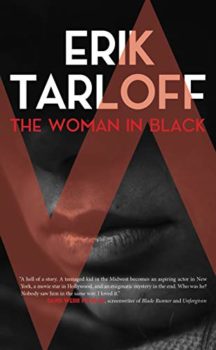
In film history, the Woman in Black was a Hollywood mystery woman who left flowers on the grave of Rudolph Valentino for 58 years. Valentino was a silent film star who died in 1926 at the age of 31. Now, in his new novel of the same name, bestselling Berkeley author Erik Tarloff brings the story up to the 1950s. And he conflates it with a figure who resembles James Dean, a heartthrob of that era in much the same way as Valentino was in his. Dean was 24 when he died in 1955.
A legendary actor like Valentino and James Dean
Tarloff’s answer to Valentino and Dean is Chance Hardwick, a brilliant and exceptionally handsome young man from the Heartland who arrives in Hollywood at a young age. In California, he quickly becomes established as an actor and then vaults to stardom in short order. As the “editor” of the book, film historian Gordon Frost, notes, “Chance Hardwick was an incandescent talent. . . But he was just getting started when he was taken from us.”
The Woman in Black by Erik Tarloff (2019) 280 pages ★★★★☆
Elsewhere, Frost describes him as “more mesmerizing than Brando, cooler than Paul Newman.” But Hardwick dies when tragically young swimming off the Malibu coast, possibly a suicide. And all he leaves behind is a handful of brilliant film performances. Plus “that old lady, that mysterious old lady dressed all in black, who still lays flowers on his grave every year on the anniversary of his drowning.” And that Hollywood mystery woman elevates Hardwick from a brilliant young talent of one era into an enduring legend for the ages.
A story told through “interviews” with four dozen characters
The story Tarloff tells in The Woman in Black is straightforward. But the way he tells the tale is not. The story advances in chronological order through a series of brief snippets from “interviews” alternating among nearly four dozen characters. A less skillful writer could easily get lost along the way, losing the thread of the plot and failing to imbue those characters with anything resembling personality. But Tarloff makes it work admirably, turning a simple tale into a psychologically revealing portrait of a troubled young man.
A Hollywood mystery woman, the Blacklist, and a legendary actor
By the end of the novel, despite all the insight from so many people who observed Chance Hardwick in life, you may not have a much greater grasp of his elusive personality than any of them. But you’ll have gained a richer understanding of Hollywood in the 1950s, the impact of the Blacklist, and the studio system that dominated the film industry from the 1920s to the 1960s. And you might brace yourself for a surprise at the end of this clever and enjoyable tale.
About the author
Erik Tarloff comes honestly to his subject matter. He has set the novel in the late 1940s and 50s at the peak of the Red Scare, when hundreds of Hollywood screenwriters, actors, directors, and others were blacklisted. Tarloff’s father, a screenwriter, was among them. And, as he told Frances Dinkelspiel of Berkeleyside in a 2014 interview, politics have always fascinated him. He contrasted his interest with that of his wife, Laura D’Andrea Tyson, former economic advisor to President Bill Clinton: “She is interested in policy, not politics. Where for me it’s kind of what football is for most guys. I like the game.”
But Tarloff’s connection to his subject runs deeper. Like his parents, he became a screenwriter. As he told Berkeleyside, “he has written more than 100 TV scripts for comedies such as M*A*S*H, All in the Family, and the Bob Newhart Show.” The Woman in Black is his fourth novel.
For related reading
Previously, I reviewed Tarloff’s excellent 2014 novel, All Our Yesterdays. See it at Sex, drugs, and revolution: Berkeley in the 70s. And Tarloff’s work is included in Good books by Berkeley writers.
For more great reading, check out Top 10 great popular novels and 20 most enlightening historical novels.
And you can always find all the latest books I’ve read and reviewed, as well as my most popular posts, on the Home Page.


























